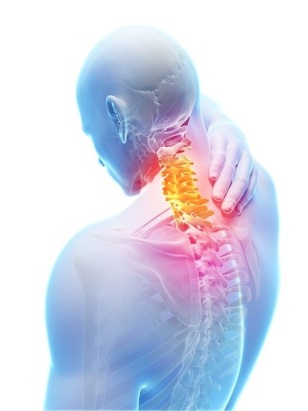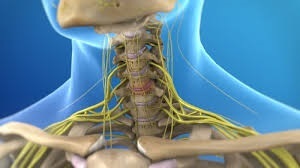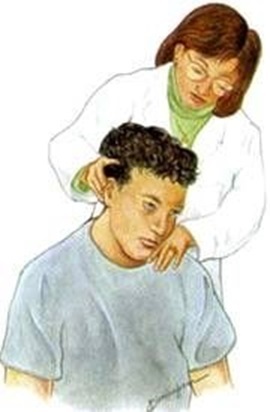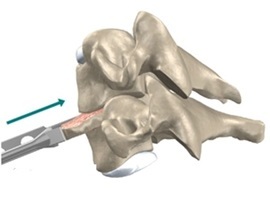Degenerative disc disease (osteochondrosis) in the cervical spine is the main cause of manifestations of pain in the neck and irradiiruet pain in the hands. Pain manifestations begin to manifest in the event that one or more of the intervertebral discs in the cervical region of the spine begin to fail due to the degeneration.
The predisposition of some people, to the development of degenerative disc disease, it is possible to have a genetic component. The injury can also speed up and can sometimes cause the development of degenerative changes in the cervical spine.
The treatment of the osteochondrosis of the cervical spine, gives good results only when you have a regular character and is consistent and systematic. The osteochondrosis of the cervical spine is in the list of the most common causes of the symptoms in patients of working age, which is long, sit at the computer. Often, patients do not pay attention on the pain and not seek medical help , which leads to complications.
The risk factors of degenerative disc disease, cervical spine

While almost all people sooner or later develop involution of degenerative changes in the cervical spine, there are some factors that can make it more likely the early development of degenerative disc disease or of the onset of symptoms. These risk factors may include:
- Genetics. Some of the studies of twins indicate that genetics plays a more important role than the style of life during the early development of osteochondrosis of the cervical spine and fast debut of symptoms.
- Obesity. The weight associated with the risk of development of the degenerate disk disease (osteochondrosis).
- The habit of smoking. This habit can prevent the entry of nutrients to the discs and speed up your hydration.
- In addition, injury to the spine can sometimes start or speed up the process of degeneration of the cervical spine.
The symptoms of the
The symptoms of degenerative disc disease, cervical spine can vary widely between different people.
When the osteochondrosis becomes symptomatic, pain may develop gradually or appear suddenly. The symptoms can vary from a certain discomfort in the neck to drain the pain with the irradiacin in the hand, numbness and / or muscle weakness.
The main symptoms:
- Pain in the neck. Low intense pain in the back of the neck stiffness is the most common symptom of osteochondrosis of the cervical spine. However, sometimes the pain may increase dramatically and last for several hours or days.
- The neuralgia. This type of pain tends to be acute, or with the feeling of electric shock with the irradiacin in the shoulder, in the sugar arm, hand and / or fingers. As a general rule, the neuralgia is felt only on one side of the body.
- The neurological symptoms in the hand, in the hand and / or fingers. It can produce sensation of pins-and-needles needles, numbness and / or weakness that may extend over the entire upper limb. These types of symptoms can interfere with daily activities, for example, to print, to dress or retain the objects.
- The pain intensifies with movement. In general, the pain caused by the degenerative disk drive, as a general rule, is intensified with movement and decreases with rest.
- If the pain comes from the most degenerate of the unit, then she is probably going to disappear by itself in the course of several weeks or months. However, other symptoms of degenerative disc disease, cervical spine turn become chronic and require treatment, for example, if facet joints in the neck also begin to degenerate and / or compression of the nerve root.
Less common symptoms
The more the cervical spine degenerates, it is more likely that the spinal canal is delimited and increase the risk of compression of the spinal cord. If there is a compression of the spinal cord , it is going to develop myelopathy and symptoms such as:
- The difficulty of movement of the hands and / or feet
- Problems with coordination and / or balance
- The loss of control of the bowel and / or bladder
- Weakness or numbness anywhere below the neck
- Shooting pain in the extremities, which can increase when you lean forward
Neoplasia myelopathy is a condition that requires immediate medical attention. Normally, this state occurs in people older than 50 years.
The diagnosis
The diagnosis of degenerative disc disease, cervical spine can be placed on the basis of such data, such as:
- Medical history. In the first place, the doctor should examine in detail the symptoms and medical history.
- Examination a physical. Then, the doctor will perform an exam, a physical, by the detection of the neck, and checking the range of motion in the neck. During the tests, the patients will have to comply with certain movements and to report, increases or decreases the pain in the neck.
- If the pain is severe or if there are neurological symptoms, such as pain, tingling, or weakness in the shoulder, the sugar arm or hand, then the doctor will probably schedule the completion of medical images .
- The methods of treatment of images (x-ray, ct scan, mri, pet). If the doctor determines that to determine the exact etiology of the sintomatologa you want to obtain images of the tissues (discs), then it is likely that is assigned to a magnetic resonance imaging. Magnetic resonance imaging, x-ray or possibly a ct scan can check if there are signs of degeneration, as well as to identify other conditions (such as osteoarthritis or stenosis), which can cause symptoms.
- After the confirmation of the accurate diagnosis of osteochondrosis of the cervical spine, as well as any other matters related to the state, we can understand the genesis of the symptoms, and to determine a program of effective treatment for.
The state associated with osteochondrosis of the cervical spine

The degeneration of the discs is often accompanied by other pathological states that are developed or at the same time, or in some cases, a is cause of another. The most common are the following states:
- A hernia in the cervical spine occurs in the case that disc degeneration leads to the alteration of the integrity of the fibrous ring and causes protrusion of contents beyond the rings. But the herniated disc can occur after injury , which ultimately accelerates the degeneration of the disc and leads to the development of degenerative disc disease, cervical spine .
- Cervical osteoarthritis. As the disc degenerates and storage space in the interior of the spinal column begins to decrease, facet joints may move abnormally and cause the wear and tear of the cartilage, as well as stimulate the formation of osteophytes in the cervical region of the spine.
- Cervical stenosis of the spine. This is a condition that occurs due to osteophytes or herniated disc and narrowing of spinal canal (where the spinal cord passes) or foraminal holes (where the nerve root).
But you have to understand that at times some people since the birth there is a narrowing of the spinal canal and the development of symptoms is not related to the osteochondrosis.
Neoplasm radiculopathy - symptoms of pain, tingling, numbness and / or weakness, radiating in the shoulder, in the hand and the brush, may occur when one or several nerve roots zaselyalsya or annoying). If stenosis occurs a compression of the spinal cord from a herniated disc, or osteophytes, may develop a myelopathy. Possible symptoms of pain, tingling, numbness and / or weakness can be felt on this level in the neck and in any place below the level of compression. For example, a person may be a tingling sensation or weakness in the legs, balance problems, or even the difficulty to control the bowel and bladder.
When there are symptoms of myelopathy, it is important to address the health care, as well as the condition may progress, without treatment, ultimately, may develop paralysis of the limbs, and dysfunction.
The treatment of the
As a general rule, when it appears the symptomatology resulting from the osteochondrosis of the cervical spine, are being medicinal actions aimed at the reduction of symptoms. In the first place, in the treatment of osteochondrosis of the cervical spine used treatments facelift non-surgical methods of treatment.

In rare cases, when pain and symptoms persist or get worse, despite several months of treatment, or if there is risk of injury of the spinal cord, then the question about the operation.
Conservative treatment options
For the treatment of pain in the neck, caused by osteochondrosis, the doctor will usually recommend that one or more of the following treatment options:
- The rest or the change of life-style. Some actions can be more painful for the neck, for example, the neck stretching forward to working with the computer. The withdrawal or modification of specific activities for several days or weeks generally reduces pain. In addition, it is recommended to keep the correct posture (in place of the bending over while sitting or bending the neck forward at the time of driving, etc). The consumption of healthy food and sufficient hydration, and quitting smoking is beneficial to the health of the disks.
- Treatment of pain with the help of medications or injections. Some effects can give OTC pain relievers. If the pain is severe, it may be assigned to more than one strong painkiller, such as oral steroids or muscle relaxers or even narcotics.
Of the injection, such as facet injection, nerve or epidural block. These can include the injection of corticosteroids in the structure defined for the reduction of local inflammation:
- Caudal epidural injections of
- The injection into the facet joint
- Interlaminar caudal epidural steroid injections
- Transforaminal epidural injections of
- Selective blocking of the nerve root
- The blocking medial branches
- The ice and the heat can be used in the treatment of osteochondrosis of the cervical spine.
- Lfk. The majority of the non-surgical treatments of the programs of treatment of osteochondrosis of the cervical spine, is to include certain programs of exercises such as isometrics and strength .The selection of the exercises should be performed a qualified specialist ( doctor lfk) , as well as the failure of exercise can worsen the condition . In addition ,the exercise should be adapted according to the individual characteristics of each person . In general, an increase in the strength and flexibility in the neck can reduce the risk of pain and to some extent to slow down the degeneration of the discs.
- The practice of chiropractic. The cervical spine can be adjusted manually by a qualified professional in the area of health, to improve the range of motion and / or reduce pain. Depending on the symptoms the patient is should perform a examination a physical and / or viewing before the hand of manipulation in the neck.
- Physiotherapy
- Massage
- Acupuncture
- Corethrogyne
The surgical treatment of osteochondrosis of the cervical spine
Methods of operation treatment of the osteochondrosis of the cervical spine, are generally considered two cases:
- Are present with neurological symptoms, such as constant hand numbness and / or weakness, or problems with walking or bowel control. If there are neurological symptoms caused by osteochondrosis of the cervical spine, there is the risk of permanent damage to the nerves, and surgery may be recommended to reduce the pressure on the nerves.
- The chronic pain is severe and does not respond to treatment for at least six months of non-surgical treatment, and daily activities becomes a problem. The best surgical results are predicted for patients with chronic pain in combination with other states, such as the instability of motion segments in the neck and / or radiculopathy.
The main surgical methods of treatment of osteochondrosis of the cervical spine are:
- Front cervical discectomy and fusion (ACDF).
- The artificial disc replacement.
In addition, there are a number of other surgical procedures for the treatment of degenerative disc disease of cervical spine:

- Endoscopic decompression alone
- Endoscopy is foraminotomy
- Decompression percutaneous
- Intra-disk uses electrothermal therapy
- Selective endoscopic discectomy
- The stimulation of the spinal cord
- Radiofrequency ablation
- Epidural lysis of adhesions
Surgical procedures in the neck, aimed at the decompression of nerve roots and / or spinal cord and, therefore, the reduction of neurological symptoms, such as pain or weakness of hands, has the tendency to be a good corner of results - a positive predictive 80% to 90% .































